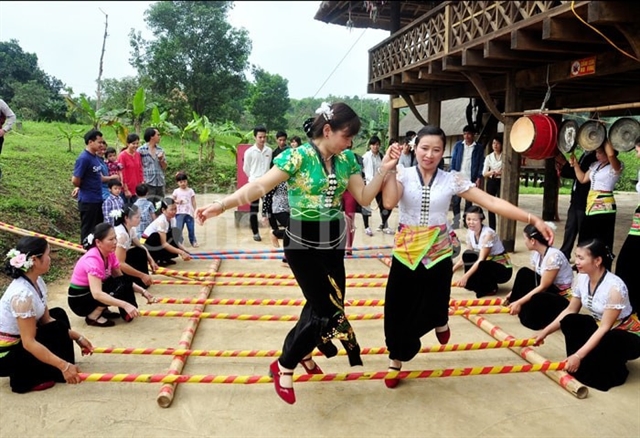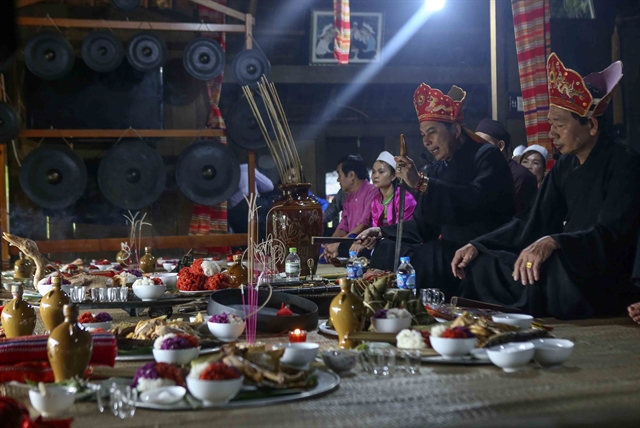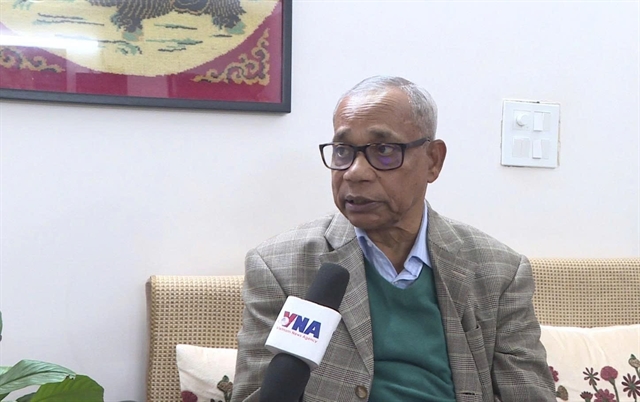 Life & Style
Life & Style

HÒA BÌNH — Over its long history, the Mường ethnic group in Hòa Bình has created and preserved a diverse folk culture.
Mo Mường rituals include reciting Mo (poetry) in which a thầy mo (shaman) plays the main role. The shaman knows tens of thousands of lines of Mo by heart, as well as many traditional rituals and customs.
In Mường society, the shaman is an intellectual and reputable person.
The role of the shaman is associated with the human life cycle: birth, old age, sickness and death. Prayers are given for people’s health, good luck, peace, happiness and prosperity.
.jpg)
|
| A shaman ties a threads on people's wrists for good luck and health. VNA/VNS Photo Tuấn Đức |
According to a survey by the provincial Department of Culture, Sports and Tourism, a total of 23 rituals are performed with Mo ceremonial singing, including funerals where tens of thousands of Mo lines are recited over 12 days and nights.
These Mo lines are divided into ‘cát Mo’ and ‘roóng Mo’, similar to chapters in literature. Each Mo chapter has its own theme and purpose in a funeral ritual. The chapters may tell folk epics, customs or lessons.
There are many collections of Mo, of which three main ones have been published. The existence of various versions of Mo has helped expand the heritage and spiritual life of the Mường people.
Mo Mường has a long life, spanning centuries, and has helped to nurture the characteristics and soul of the Mường people.

|
| A shaman performs Lễ mát nhà (house-cooling ceremony), one of the typical rituals of the Mo Mường people. VNA/VNS Photo Tuấn Đức |
According to folk cultural specialists, Mo Mường is classified into three categories: Mo Nghi Lễ (Ceremonial Mo), Mo Kể Chuyện (Story Telling Mo) and Mo Nhòm (Observe Mo), in which a shaman plays an important role.
Mo Mường is expressed in diverse ways, including:
Efforts to preserve Mo Mường
Besides reflecting the unique culture of the Mường people, Mo Mường contains educational values for the community. The educational value of Mo Mường remains relevant in life today. It is an oral textbook.
However, this intangible cultural heritage is in danger of becoming extinct due to industrialisation and globalisation.
In Hòa Bình, the number of shamans in villages has decreased. Statistics from the provincial Department of Culture, Sports and Tourism showed that the province only has 190 shamans left, many of them very old.
In order to protect this intangible cultural heritage, the provincial Party Committee has issued many documents which identify Mo Mường as a heritage that needs to be preserved and promoted.
Since 2010, Hòa Bình has put forward specific solutions to preserve the culture such as supporting the publication of a three-volume book featuring 22,000 lines of Mo verses collected and edited by folk researcher Bùi Văn Nợi.
In 2016, the Ministry of Culture, Sports and Tourism issued a decision bringing Mo Mường into the list of national cultural heritage.
In 2020, Deputy Prime Minister Vũ Đức Đam assigned the ministry to work with relevant ministries and localities to compile a dossier to submit to the Prime Minister to seek UNESCO recognition for Mo Mường as a world cultural heritage item.
With efforts in preserving and promoting the cultural heritage values of Hòa Binh, the unique features of Mo Mường will continue to be developed by future generations. VNS




